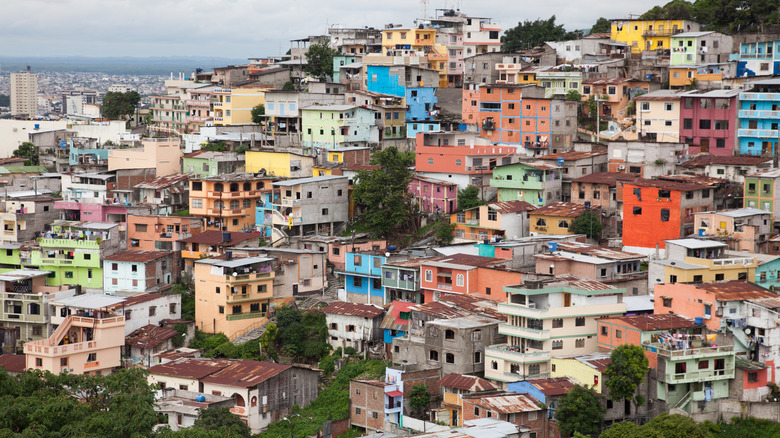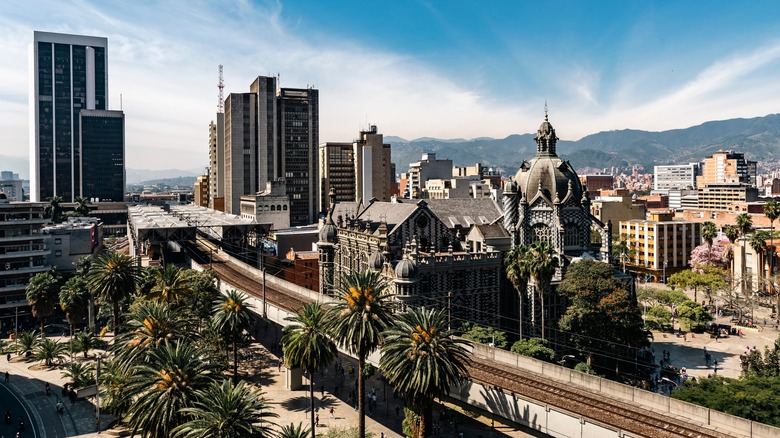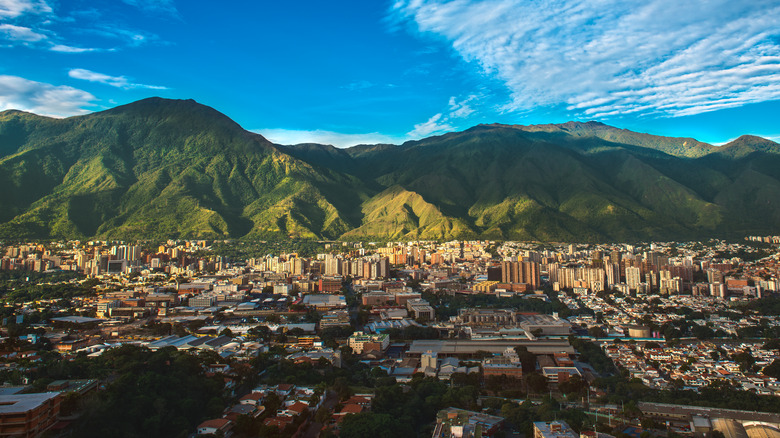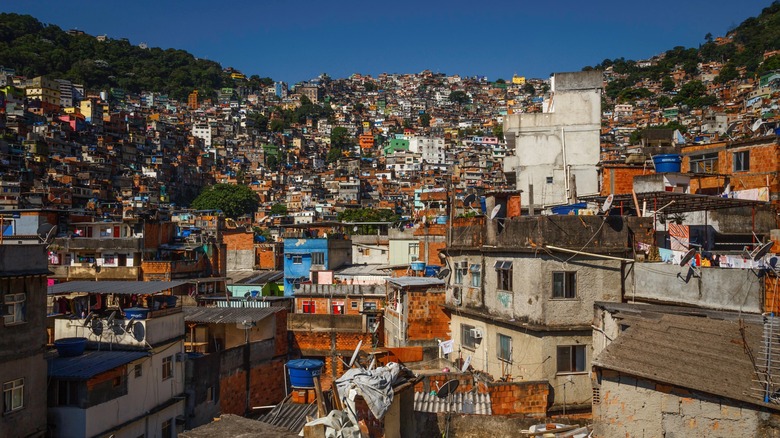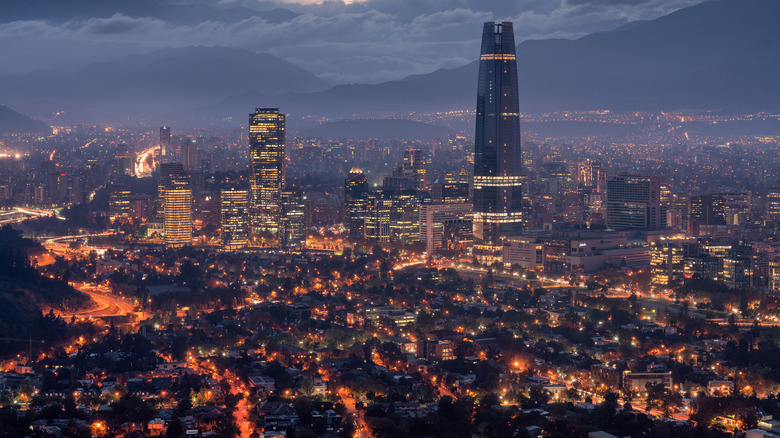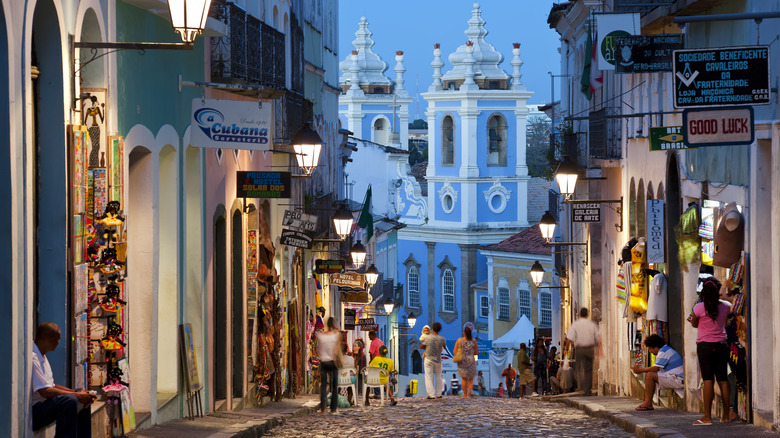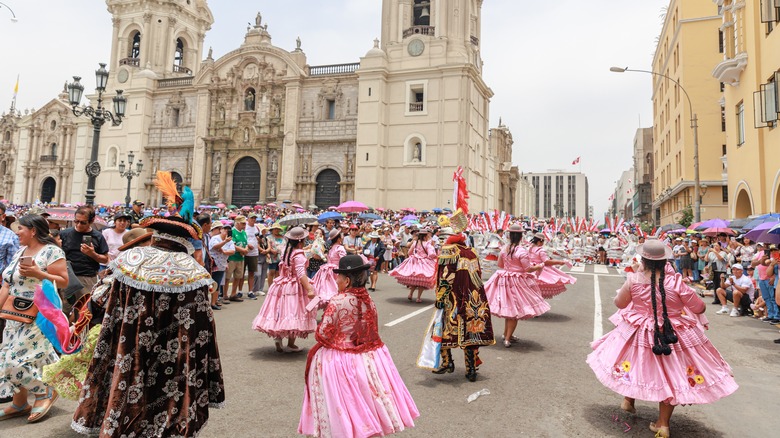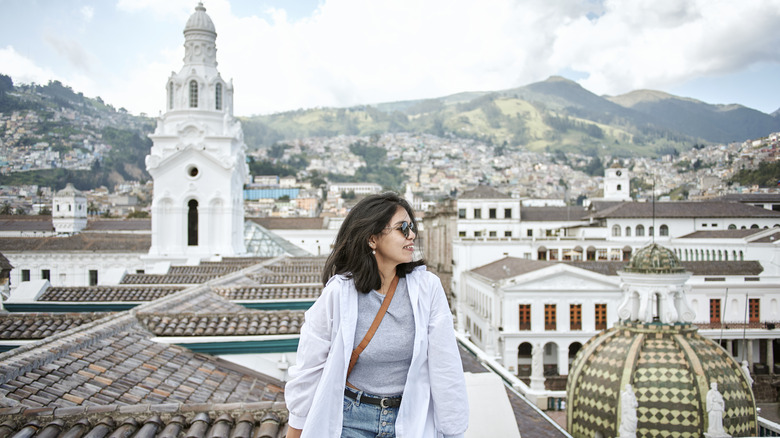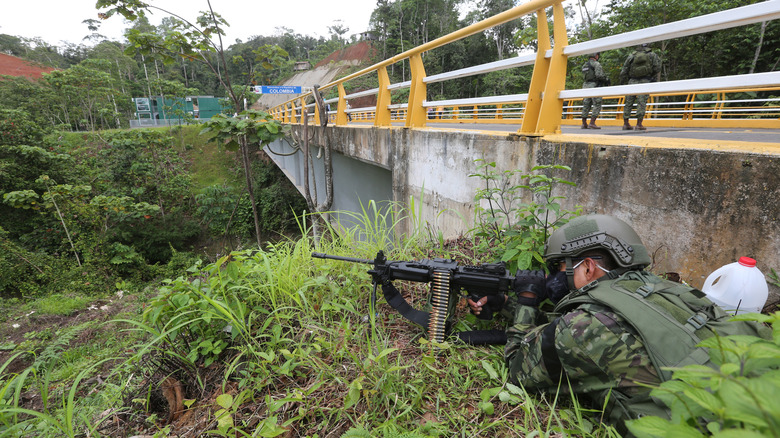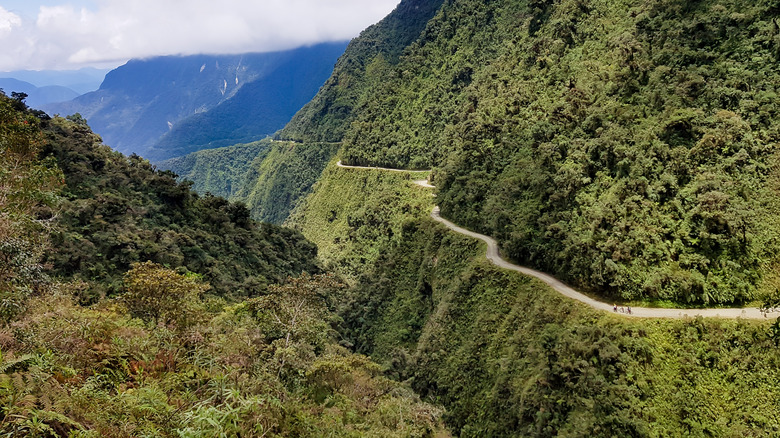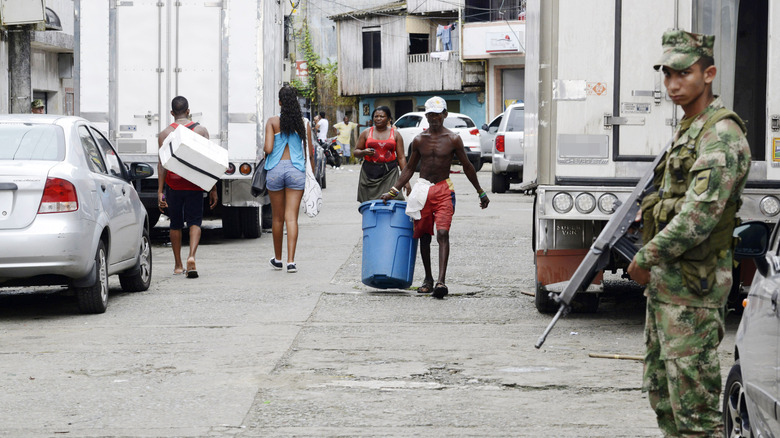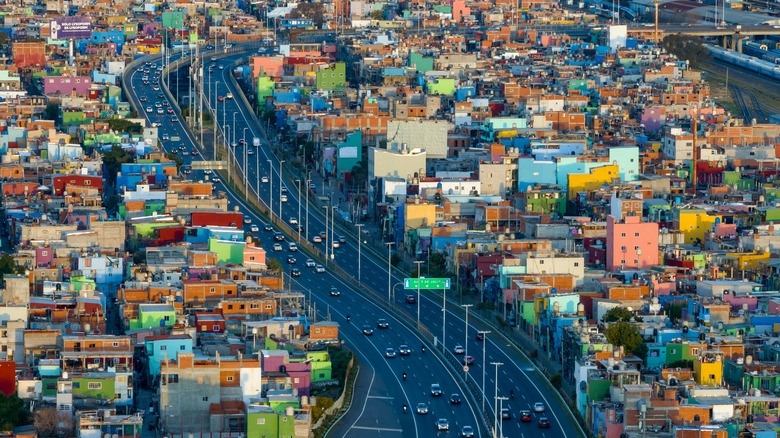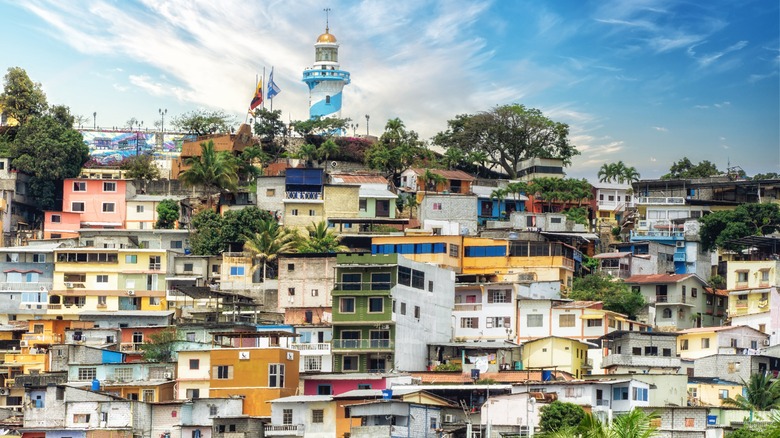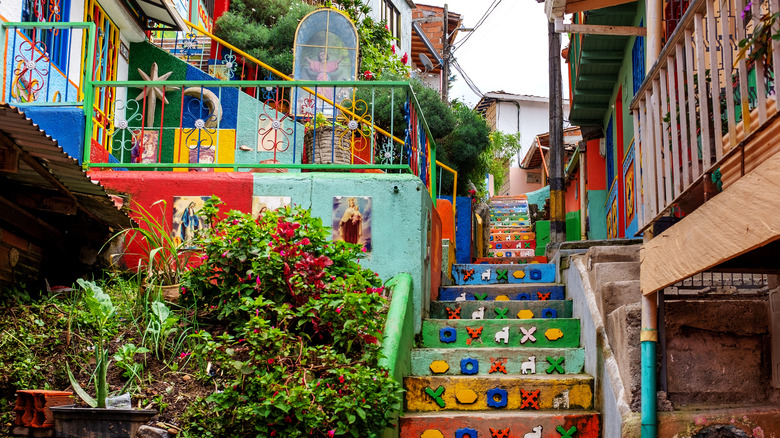Think Twice Before Visiting These Dangerous South American Destinations
South America's bustling cities and vibrant cultures draw tourists from across the world. But make no mistake, there are some destinations across the continent that even seasoned travelers may want to think twice about visiting. Though history buffs may love the idea of treading the same streets as drug kingpin Pablo Escobar in Medellín, trying out one of Brazil's famous caipirinha cocktails in a favela, or hiking one of South America's most iconic trails, we'd recommend researching the destination before booking your next flight.
Of course, there are advantages and disadvantages to every destination, but crime statistics help us dodge areas where the bad outweighs the good. In 2021 alone, there were 55,100 gun-related homicides in South America, according to a 2023 global study published by the United Nations. Some places are better avoided if you want a stress-free trip where you can feel safe to explore. Considering these destinations' political situations and government travel advisories, here are some places you should avoid for now.
Medellín, Colombia
Many remember Medellín, Colombia, as the stomping ground of infamous cartel leader, Pablo Escobar. During his reign throughout the 1980s and early '90s, Escobar brought with him violence and wealth. Some locals have surprisingly fond memories, with many calling him by his beloved nickname, Pablito. Though Escobar's cartel is no longer in operation, Medellín can still be a dicey place to visit.
Political Science Professor Pedro Piedrahíta Bustamante at the University of Medellín told The Guardian, "Medellín is a nucleus of transnational crime networks." He emphasized that weapons were a big issue, adding, "That's why, despite all the transformations of the last decades, negative indicators of crime persist in the city." The U.S. Embassy in Colombia also reported several homicides of American citizens in 2023 that seem to have targeted victims through dating apps. The United States government has issued a level 3 (of 4) warning against travel to the entire country.
However, the overall crime rate in Medellín continues to drop, and many intrepid travelers are flocking to the city to enjoy its comfortable climate, delicious street food, and world-famous coffee. It's also an excellent place to practice your Spanish, as the Colombian accent is often considered the easiest for foreigners to understand. The relatively low cost of living has made it an increasingly popular destination among backpackers and digital nomads. Staying alert, avoiding dating apps, not engaging in illegal activities, and researching neighborhoods to avoid can reduce risk on a trip to Medellín.
Caracas, Venezuela
Venezuela's capital, Caracas, was once a cultural and economic hub nicknamed Heaven's Branch on Earth. Despite its geographic location at the foot of lush mountains and the country boasting the world's largest oil reserves, prolonged political unrest has led to extreme poverty, widespread violence, and serious crime. Armored vehicles — that are bullet proof and heat-resistant — are common in Caracas and considered the safest way to travel, particularly after sunset. Public transport is not recommended at any time of day, and both buses and metro trains can be unsafe due to reports of armed robberies.
The United States government has issued the highest-risk level 4 travel advisory urging citizens not to travel to Venezuela, largely due to the capital's high crime rate, including frequent robbery, kidnapping, and murder. It's worth noting Caracas is also prone to regular power cuts, meaning that flights delays and cancellations are common.
Venezuela is home to some incredible wildlife, from jaguars to capybaras, and if you need to travel to Caracas, visiting one of the multiple zoos is an excellent way to learn about endemic species. The city is also known for its impressive modernist and brutalist architecture, and going on a private tour with a reputable company let's you learn about these buildings with the guidance of a knowledgeable local. Arepas, cornmeal flatbreads stuffed with various fillings from avocado to shredded meat and cheese, are a culinary staple.
The favelas in Brazil
Rio de Janeiro beaches are among some of the most beautiful in the world, so it's not hard to see why many travelers have this popular Brazilian city on their bucket list. The densely populated, sun-kissed location is home to over 16 million people, and there are some incredible destinations to see, including Copacabana Beach and the iconic Christ the Redeemer statue — one of the New Seven Wonders of the World.
The vibrant neighborhoods of Santa Teresa and Ipanema are relatively safe to explore, but visitors should avoid venturing into the city's favelas. These poverty-stricken informal settlements have a distinct creative and cultural influence on the rest of Brazil, and are where some of the country's most successful musical artists and athletes grew up. However, favelas are prone to gang violence and tourists are easy targets for robbery and other crimes. The United States government has issued a level 4 highest-risk travel advisory urging visitors not to enter favelas under any circumstances, even on guided tours. Theft is a common crime and can sometimes escalate, so tourists should take care no matter where they are in the city.
That said, Rio is home to the largest Carnival celebration in the world, and millions of people come together to celebrate the week-long festival leading up to Lent. Outdoor enthusiasts will find incredible hiking, rock climbing, surfing, and diving opportunities. Rio is also a breathtaking destination where you can swim with turtles.
Santiago, Chile
Santiago is the economic hub of Chile and home to almost 7 million people, with bustling markets, European-inspired squares, and pedestrian streets. However, the U.S. Department of State has issued a level 2 travel advisory, asking visitors to exercise a higher degree of caution throughout Chile because of its volatile civil unrest. Due to the unbalanced political state, ad-hoc demonstrations often cause chaos with road closures, protests, and army tanks taking to the streets to quell crowds in response.
Scams and other illegal activities are also rife in the city, especially when it comes to getting to and from the airport. The U.K. government warns against unofficial taxi drivers who often pose as regulated businesses, luring customers into their cabs only to charge them an excessive fee. The best way to avoid this when visiting Santiago is to book your journey in advance with a service like Transvip or Uber.
To see the city from a scenic vantage point, take the funicular to the top of Cerro San Cristóbal. You can also walk, but it's a pretty steep one-hour climb! Police are present and it's a busy point of interest with lots of other hikers and runners, so it's a safe activity during the day but best to avoid after nightfall. As always, keep an eye on your belongings and exercise a reasonable degree of caution. Perhaps surprisingly, "vianesas," or hot dogs, are one of the most popular dishes in Chile.
Salvador da Bahia, Brazil
Take a short stroll around the cobbled streets of Salvador da Bahia in Brazil, and you'll be transfixed by welcoming storefronts, brightly painted buildings, and the gentle sound of music coming from one of the city's many festivals. There is plenty to draw tourists, but opportunists looking to make a quick buck are all too aware that they can be easy pickings. The U.S. government has a level 2 travel advisory for most of Brazil, including Bahia. Tourists should exercise a higher degree of caution, and comply if confronted by a robbery to avoid escalation or violence.
Data collected by the Armed Conflict Location & Event Data (ACLED) Project in 2023 showed worrying statistics. As published by Insight Crime, the ongoing battle between organized crime outfits and the authorities was to blame for an estimated 1,700 deaths in the locality. The upset and threat of violence in Salvador is a particular problem for residents. Gabriela Ashanti, project manager at the Odara Institute in Bahia, told the publication, "Some areas of the city were paralyzed, including schools, health centers and buses — public transport not running in certain areas at certain times as a result of these conflicts."
Exploring the colorful streets in safe neighborhoods like Barra and Santo Antônio Além do Carmo, and visiting Pelourinho, a historic district on the UNESCO World Heritage list, are great ways to spend the day. You can also enjoy the sun on one of the city's many beaches.
Lima, Peru
If culture and a rich history are what you're after, Lima, Peru, has it by the bucket load. Full of museums and home to some of the most famous under-the-radar ancient ruins in the world, Lima's significance can't be underestimated. But all that glitters isn't always Incan gold. In 2023, a jump in crime rates sparked Peru's president, Dina Boluarte, to declare a state of emergency in some districts. Organized crime caused chaos in the city and the military was called in to address it.
Crime complaints reached new heights with more than 160,000 in 2022 — up 33% from 2021. If that data isn't enough to put you off, the U.S. government has issued a level 2 travel advisory due to crime, including daylight robberies and the risk of kidnapping. Travelers would be wise to refrain from taking part in hallucinogenic drug ceremonies, such as ayahuasca and kambo. While it may seem like an enlightening experience, travelers have fallen victim to serious crimes while under the influence, from robbery to sexual assault.
The situation seems to be settling, and Lima is on track to become a safe destination once more, but tourists may want to consider alternative destinations for the time being. If you find yourself in Lima, be sure to visit Huaca Pucllana, a site with pre-Incan ruins that offer a fascinating glimpse into what life was like circa 500 C.E. You can find Huaca Pucllana in Miraflores, one of the safer neighborhoods in Lima.
Quito, Ecuador
Nestled on the lower slopes of a volcano in an Andean valley is Quito, Ecuador's capital. Quito made the UNESCO World Heritage list thanks to its preserved market hub and long and storied history. But while it's certainly worthy of its title, Quito has plenty of problems. In early 2024, things came to a head when gunmen barged their way onto a live TV broadcast in another of Ecuador's cities, Guayaquil.
Though this particular ruckus didn't take place in the country's capital, the unrest was felt there. Looters made their way through downtown Quito as the military took to the streets, and gangs were quick to push back on the president's declaration of a war on crime. Four police officers were kidnapped, including one from Quito. As a result, it's not hard to see why the U.S. government has issued a level 2 travel advisory and would rather visitors pick somewhere else to go unless absolutely necessary, given the ongoing upset.
Perhaps obvious because of the country's name, Ecuador sits on the equator. You can visit the Middle of the World monument just a few miles north of Quito, and stand with a foot on each half of the world. The capital city is also one of just two airports that connect you to the Galapagos Islands, known for their unique biodiversity, diving, and hiking.
The red zones in Colombia
Chances are that if you keep up with the state of the world, you've heard of Colombia's infamous red zones. Venture into these areas as a tourist, and you're putting your life into the hands of fate, and it may not be kind. These dangerous locations in Colombia, such as Guaviare, are characterized by the presence of guerrilla groups, and they don't take kindly to strangers. Kidnappings are common in these areas, so it's best not to plan a trip here any time soon.
These paramilitary groups are plentiful and strong in numbers. According Colombia Reports, to The Gaitanista Self-Defense Forces of Colombia has an estimated 7,000 members, while the National Liberation Army, a far-left Marxist guerrilla organization, is 3,000 strong. The latter also happens to be the largest drug cartel in the country. Villagers in these red zones live in fear of being targeted by guerilla groups if they support the wrong outfit. These red zones change depending on where conflict is taking place, but are typically concentrated around the borders with Venezuela, Panama, and Ecuador.
When going to and from Colombia, it's best to fly to your destination rather than travel through these high-risk zones. The U.S. government's level 3 travel advisory for Colombia is raised to 4 in these areas, recommending citizens not visit under any circumstances. Alternative destinations in Colombia include Guatapé, Cartagena, and Minca, where safety is less of a concern.
The Death Road in Bolivia
While many of the other locations we've discussed are no-go areas due to political unrest, organized crime, or higher-than-average homicide rates, this particular destination has its infrastructure to blame. Near the Cumbre Pass in Bolivia lies one of the most treacherous roads in the entire world. Aptly dubbed "Camino de la Muerte," aka Death Road, the beaten path is a high-altitude combination of stomach-churning bends and narrow roads. Nothing stands between the road and its sheer cliffs, with drops of over 1,000 feet, meaning accidents seldom end well for travelers.
Despite being dubbed the world's most dangerous road by the Inter-American Development Bank, it's become somewhat of a magnet for thrill-seekers wanting to see just how close to the edge they can get. Though the views are undeniably breathtaking and otherworldly, getting the perfect photo can come at much too high a price. Around 200 people die on the Death Road every year, making it one of the most macabre places in the region.
Given its situation, it's not hard to see why many motorists succumb to the track's volatility. Travelers who take the risk will see a fast and heady mix of cyclists, motorcyclists, and pedestrians. In short, hazards are everywhere, and even extreme caution might not be enough to avoid a life-changing — or life-ending — accident. Steer clear of this reckless mistake and take another road instead!
Buenaventura, Colombia
When considering which destinations you should and shouldn't visit, travel guides are essential. Making sure you do adequate research can be the difference between having a grand old time or unwittingly stepping foot into one of the most dangerous areas in a continent, just like Buenaventura, Colombia. On the surface, the port city may seem like a relatively unassuming place, but don't let the book fool you by its cover.
Any town dubbed the "Capital of Horror" shouldn't be on your must-visit list. In 2021, local resident Tatiana Angulo told The Guardian about the murder of her neighbor's teenage sons. "They got mixed up in it," she explained. "We used to be able to hang out and have a laugh on the street corners, but now that's where the killings happen." Angulo went on to say that she was scared for her life and hopes for peace. Despite how bad the situation is, locals are afraid to speak out against the paramilitary groups that reign in case they find themselves victims.
While the U.S. government hasn't issued a formal advisory for the port city, it does maintain a level 3 travel advisory encouraging citizens to reconsider any trip to Colombia. Additionally, the Canadian and U.K. governments recommend that people avoid all travel to Buenaventura. Despite being a high-risk destination, Buenaventura sits between two beautiful national parks, is a great destination for whale watching, and hosts several vibrant festivals throughout the year.
Villa 31, Argentina
Similar to Rio's favelas, Buenos Aires has its own informal settlements, known as "villas de emergencia" or "emergency settlements" in Argentina. The sprawling community of Villa 31 is home to 40,000 people and surrounds the Illia highway near the port. Not only is the infrastructure virtually non-existent (Villa 31 has no electricity and a makeshift sewage system), but the buildings are piled upon each other precariously, leading to another set of issues.
Break-ins are so common that many building owners go to the length of covering them wholly with metal cages. According to local newspaper, La Nacion, this underprivileged area had the second-highest murder rate in the city in 2019, and travelers would still do well to avoid it today. YouTuber Indigo Traveller dared to venture through the locality in 2023, and his findings weren't surprising. The host, Nick, spoke to a man working for the local fire service who said two to three people fall from buildings every day. One Redditor also took to the platform to tell their tale of walking into Villa 31. Though they came to no harm, they were warned by Villa 31 shopkeepers to leave rather than go any further.
Buenos Aires is, otherwise, one of the safest destinations in South America. The U.S. government has assigned it a level 1 travel advisory — the lowest ranking — indicating travelers can enjoy a comfortable visit. Be sure to visit Teatro Colon, an old theatre-turned-book store, and the colorful neighborhood of La Boca.
Guayaquil, Ecuador
Like many cities in Ecuador, Guayaquil has fallen victim to the crime surge across the country in recent years. The city has a very high murder rate, and even though the majority of it is gang-related, it is not unheard of for tourists to get caught in the mix. In early 2024, a group of people toting guns and other weapons barged their way onto a live TV broadcast in the city of Guayaquil. Things escalated in the months that followed after Ecuador's president declared war on crime. In March of the same year, CBS reported that nine people were killed in an attack in the neighborhood of Guasmo, and five tourists died after being mistaken for rival gang members.
The U.K. government advises travelers to be aware of disruption such as (usually fake) bomb threats and explosions, often carried out by criminals looking to cause unrest. It's easy to see why the U.S. has issued a level 2 travel advisory for the country. Some regions, including Guayaquil, have an elevated risk and level 4 advisory due to concentrations of gang activity in public areas.
Guayaquil is often called the gateway to The Galapagos Islands, but has many worthwhile sites to see in its own right. The colorful hillside neighborhood of Santa Ana leads to a blue and white-striped lighthouse, and you can find hundreds of iguanas roaming Parque Bolivar.
Methodology
South America is a sprawling continent consisting of 12 countries and almost 400 million people. It's home to some breathtaking sites, historical wonders, and rich cultures, making it a sought-after region to explore. However, it's important to realize that some areas are less advisable to visit than others.
We scoured government websites, blogs, and news sources to find important crime statistics that helped us compile a comprehensive list of destinations to avoid when visiting this beautiful part of the world. If your wanderlust gets the best of you and you find yourself in one of these localities, always be sure to check current travel advice and exercise higher-than-normal caution. After all, coming home safely is the end goal of any successful trip.
